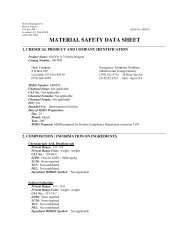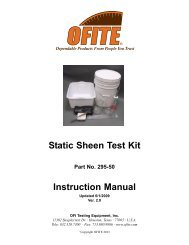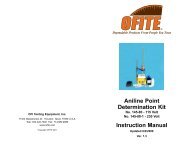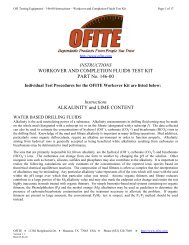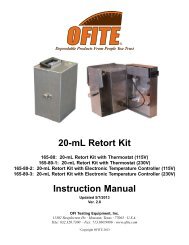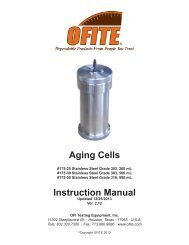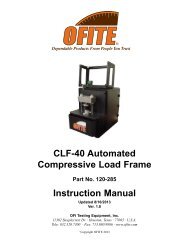English - OFI Testing Equipment, Inc.
English - OFI Testing Equipment, Inc.
English - OFI Testing Equipment, Inc.
Create successful ePaper yourself
Turn your PDF publications into a flip-book with our unique Google optimized e-Paper software.
Pressurized Fluid Density Scale<br />
Part #: 100-70<br />
Instruction Manual<br />
Updated 3/12/2013<br />
Ver. 1.6<br />
<strong>OFI</strong> <strong>Testing</strong> <strong>Equipment</strong>, <strong>Inc</strong>.<br />
11302 Steeplecrest Dr. · Houston, Texas · 77065 · U.S.A.<br />
Tele: 832.320.7300 · Fax: 713.880.9886 · www.ofite.com<br />
©<br />
Copyright <strong>OFI</strong>TE 2013
Table of<br />
Contents<br />
Intro....................................................................................................2<br />
Description........................................................................................2<br />
Components......................................................................................3<br />
Operation ..........................................................................................4<br />
Calibration.........................................................................................7<br />
Maintenance......................................................................................9<br />
<strong>OFI</strong>TE, 11302 Steeplecrest Dr., Houston, TX 77065 USA / Tel: 832-320-7300 / Fax: 713-880-9886 / www.ofite.com 1
Intro<br />
Drilling fluids and cements often have a considerable amount of air<br />
entrained or trapped within the fluid that may give erroneous results when<br />
determining fluid density using conventional equipment. This air volume<br />
may be decreased to a negligible quantity by pressurizing the sample cup,<br />
which will then give more accurate density readings of the fluid itself.<br />
Description<br />
The <strong>OFI</strong>TE Pressurized Fluid Density Scale is similar to a standard mud<br />
balance. A sample cup of known volume is balanced by a fixed counterweight<br />
at the opposite end of a balance beam. A sliding weight rider<br />
moves along the graduated scale and a level bubble on the beam indicates<br />
when the system is in balance. The position of the rider on the graduated<br />
scale indicates the density of the sample.<br />
In the center of the lid is a check valve that allows a one-way flow of test<br />
fluid into the sample cup. A plunger attaches to the check valve and<br />
applies pressure to the sample cup. When the pressure in the sample cup<br />
increases, the check valve automatically closes, sealing off the pressure<br />
inside. A cap holds the lid in place.<br />
The balance beam has four graduated scales:<br />
- 52 - 164 lb / ft 3<br />
- 6.9 - 21.9 ppg<br />
- .83 - 2.63 specific gravity<br />
- 360 - 1130 PSI / 1000 ft<br />
<strong>OFI</strong>TE, 11302 Steeplecrest Dr., Houston, TX 77065 USA / Tel: 832-320-7300 / Fax: 713-880-9886 / www.ofite.com 2
Components<br />
#100-29 Level Bubble Vial<br />
#100-56 Lead Shot<br />
#100-60-09 Check Valve<br />
#100-60-24 Retaining Ring for Check Valve<br />
#100-70-01 Sample Cup and Mud Arm Assembly<br />
#100-70-02 Lid<br />
#100-70-03 Cap<br />
#100-70-04 Rider<br />
#100-70-05 Shot Well<br />
#100-70-06 O-ring for Lid<br />
#100-70-07 Plunger Assembly<br />
#100-60-13 Packing Cup, Plastic<br />
#100-70-010 Knob<br />
#100-70-11 Piston Rod<br />
#100-70-13 Compression Cylinder<br />
#100-70-14 Lower Plunger Cap<br />
#100-70-15 Upper Plunger Cap<br />
#170-07 O-ring<br />
#100-70-08 Carrying Case<br />
#100-70-24 Base<br />
#100-70-25 Cover for Level Bubble Vial<br />
#115-32 Knife Edge<br />
#142-54 O-ring for Check Valve Nozzle<br />
#142-56 O-ring for Check Valve<br />
Optional:<br />
#100-70-101 Calibration Fixture<br />
#100-70-SP Spare Parts Kit<br />
#100-60-24 Retaining Ring, Qty: 2<br />
#100-70-06 O-ring for Lid, Qty: 6<br />
#142-54 O-ring for Check Valve Nozzle, Qty: 6<br />
#142-56 O-ring for Check Valve, Qty: 4<br />
#100-60-13 Packing Cup for Plunger Assembly, Qty: 3<br />
#170-07 O-ring for Plunger Assembly, Qty: 4<br />
Check Valve (#100-60-09)<br />
Lid (#100-70-02)<br />
O-ring (#142-54)<br />
Retaining Ring<br />
(#100-60-24)<br />
O-ring (#142-56)<br />
O-ring (#100-70-06)<br />
<strong>OFI</strong>TE, 11302 Steeplecrest Dr., Houston, TX 77065 USA / Tel: 832-320-7300 / Fax: 713-880-9886 / www.ofite.com 3
Operation<br />
1. Fill the sample cup to within ¼" of the top with fluid to be tested.<br />
2. Push the check valve down to open it.<br />
3. Place the lid on the sample cup and press it down slowly.<br />
<br />
Tip<br />
!<br />
Important<br />
As you press the lid into the sample cup, fluid should leak out of the<br />
check valve. If no fluid leaks from the check valve, remove the lid and<br />
add more fluid.<br />
Be careful when pressing the lid into the sample cup. Test fluid may<br />
spray out of the check valve. Always press the lid slowly and remember<br />
to wear protective eyewear.<br />
4. Place the cap over the lid and screw it in place.<br />
Cap<br />
Check Valve<br />
Lid<br />
Sample Cup<br />
Level Bubble<br />
Arm<br />
5. Push the plunger all the way into the plunger cylinder.<br />
Plunger Cylinder<br />
Plunger<br />
<strong>OFI</strong>TE, 11302 Steeplecrest Dr., Houston, TX 77065 USA / Tel: 832-320-7300 / Fax: 713-880-9886 / www.ofite.com 4
6. Place the end of the plunger cylinder into the test fluid and pull the<br />
plunger all the way out. This will draw test fluid into the plunger cylinder.<br />
7. Place the end of the plunger cylinder over the top of the check valve.<br />
8. With one hand, press down on the plunger cylinder to keep the check<br />
valve open. With the other hand, press down on the plunger to apply<br />
approximately 50 lb of force.<br />
Plunger<br />
Check<br />
Valve<br />
Check Valve Open<br />
Check Valve Closed<br />
9. While continuing to apply 50 lb of force to the plunger, slowly raise the<br />
plunger. This will allow the check valve to pop up, sealing off the pressure<br />
inside the sample cup.<br />
10. When the check valve has risen about ¼", stop applying force to the<br />
plunger and remove it from the valve.<br />
<strong>OFI</strong>TE, 11302 Steeplecrest Dr., Houston, TX 77065 USA / Tel: 832-320-7300 / Fax: 713-880-9886 / www.ofite.com 5
11. Clean and dry the outside of the sample cup and balance arm.<br />
12. Balance the instrument with the knife edge resting on the base.<br />
13. Move the rider back and forth until the arm is balanced. When the arm<br />
is balanced, the bubble in the level will be between the two lines.<br />
14. Read the density from the scale printed on the arm.<br />
Knife Edge<br />
Base<br />
Rider<br />
<strong>OFI</strong>TE, 11302 Steeplecrest Dr., Houston, TX 77065 USA / Tel: 832-320-7300 / Fax: 713-880-9886 / www.ofite.com 6
Calibration<br />
Basic Calibration<br />
The Pressurized Fluid Density Scales are calibrated at the factory prior to<br />
shipment. Use the following procedure to confirm the unit is still in calibration.<br />
1. Clean the entire instrument.<br />
2. Fill the sample cup with clean, fresh water and pressurize it.<br />
3. Balance the instrument with the knife edge resting on the base.<br />
4. Move the rider to 1.00 on the specific gravity scale.<br />
5. Observe the level bubble. If the bubble is off center, the instrument is<br />
out of balance.<br />
6. Unscrew and remove the shot well.<br />
7. If the bubble is closer to the sample cup, remove lead shot from the<br />
shot well. If the bubble is closer to the shot well, add lead shot.<br />
8. Screw the shot well back into the arm.<br />
9. Repeat steps 3 through 8 until the level bubble is centered.<br />
Sample Cup Rider Shot Well<br />
<strong>OFI</strong>TE, 11302 Steeplecrest Dr., Houston, TX 77065 USA / Tel: 832-320-7300 / Fax: 713-880-9886 / www.ofite.com 7
Re-qualification Calibration:<br />
If the balance is ever damaged or any non-consumable parts are replaced<br />
(lid, cap, check valve, rider, or shot well), a more thorough calibration will<br />
be necessary.<br />
1. Perform the basic calibration described on page 7.<br />
2. Remove the water from the sample cup and thoroughly clean and dry<br />
the instrument.<br />
3. Place the lid and cap back on the sample cup.<br />
4. Attach the calibration fixture (#100-70-101) to the sample cup.<br />
Calibration Fixture<br />
5. Adjust the weights on the fixture until the unit balances at 1.00 specific<br />
gravity. Lock the weights so they do not move.<br />
6. Fill the sample cup with clean, fresh water and pressurize it.<br />
7. Perform another basic calibration as described on page 7. The unit<br />
should balance at 2.00 specific gravity.<br />
<strong>OFI</strong>TE, 11302 Steeplecrest Dr., Houston, TX 77065 USA / Tel: 832-320-7300 / Fax: 713-880-9886 / www.ofite.com 8
Maintenance<br />
1. Before every test, inspect the o-ring on the lid and the two o-rings on the<br />
check valve. Make sure they are not brittle, chiped, torn, or stretched. If<br />
any o-ring shows signs of wear, replace it with a new o-ring.<br />
2. After each test, thoroughly clean the instrument, including the plunger,<br />
with water and an appropriate solvent. Make sure no test fluid (especially<br />
cement) remains on any surfaces. Repeatedly fill and purge the<br />
plunger assembly to remove any test fluid.<br />
3. Always store the instrument clean and dry in the provided carrying<br />
case.<br />
<strong>OFI</strong>TE, 11302 Steeplecrest Dr., Houston, TX 77065 USA / Tel: 832-320-7300 / Fax: 713-880-9886 / www.ofite.com 9



